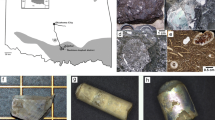Abstract
The Cretaceous sediments of the Ariyalur area, southern India, are the largest and the most important of all the exposures of that system in southern India. Oyster bivalves are common in these Cretaceous sediments. More than twenty species belonging to fifteen genera are known from the Ariyalur area. They are distributed in almost all the rock formations representing ages ranging from Late Albian to Maastrichtian. The abundance, preservation and restricted ranges of these bivalve species in the Cretaceous of Ariyalur area offer scope for biozonation. They seem to play a role as markers of sedimentary units by their apparent accumulation. This study attempts to interpret the palaeoenvironment of deposition based on size, distribution and carbon isotope study of the shells, the petrology of the associated rocks and inferences based on other groups of fossils including invertebrates, vertebrates and plant fossils.
Similar content being viewed by others
References
Ayyasami, K., 1990, Cretaceous heteromorph ammonoid biostratigraphy of southern India. Newsletters on Stratigraphy, Stuttgart, 33, 2/3, 111–118.
Ayyasami, K. and Banerji, R.K., 1984, Cenomanian-Turonian transition in the Cretaceous of southern India. Bulletin of the Geological Society of Denmark, Copenhagen, 33, 21–30.
Ayyasami, K. and Rao, B.R.J., 1980,Goniomya from the Trichinopoly Group, Upper Cretaceous, Tamil Nadu, Journal of the Geological Society of India, Bangalore, 21, 354–357.
Ayyasami, K. and Rao, B.R.J., 1984, Observation on the biostratigraphic zones of the Trichinopoly Group (Upper Cretaceous), Tamil Nadu. Proceedings of the X Indian Colloquium on Micro-palaeontology and Stratigraphy, Pune, pp 223–230.
Ayyasami, K. and Rao, B.R.J., 1996. Dispersal of Cretaceous inocramids in Gondwanaland. Proceedings of the 9th International Gondwana Symposium, Hyderabad, 1, 339–354.
Banerji, R.K., 1972, Stratigraphy and micropalaeontology of the Cauvery Basin, part-I. Exposed area. Journal of the Palaeontological Society of India, 17, 7–30.
Blanford, H.F., 1862. On the Cretaceous and other rocks of South Arcot and Trichinopoly districts. Memoirs of the Geological Survey of India, 4, 217p.
Chiplonkar, G.W. and Tapaswi, P.M., 1976, Bivalvia from the Upper Cretaceous of Trichinopoly district, South India, Part I, Inoceramidae. Recent Researches in Geology, 3, 87–123.
Chiplonkar, G.W. and Tapaswi, P.M., 1979, Biostratigraphy, age and affinities of the bivalve fauna of the Cretaceous of Tiruchirapalli District, South India, Miscellaneous Publication of the Geological Survey of India, 45, 137–164.
Forbes, E., 1846, Report on the fossil invertebrates from southern India, collected by Mr. Kaye and Mr. Cunliffe. Transactions of the Geological Society of London, 7, 97–174.
Fursich, F.T. and Pandey, D.K., 1999, Genesis and environmental significance of Upper Cretaceous shell concentrations from the Cauvery Basin, southern India. Palacogeography, Palaeoclimatology, Palaeoecology, 145, 119–139.
Hart, M.B., Bhaskar, A. and Watkinson, M.P., 2001, Large foraminifera from the Upper Cretaceous of the Cauvery Basin, S.E. India. Memoirs of the Geological Society of India, 46, 159–171.
Kennedy, W.J., 1984, Ammonite faunas and the ‘standard zones’ of the Cenomanian to Maastrichtian Stages in their type areas, with some proposals for the definition of the state boundaries by ammonites. Bulletin of the Geological Society of Denmark, 33, 147–161.
Mohabey, D.M., 2001, Indian dinosaur eggs: a review. Journal of the Geological Society of India, 58, 479–508.
Moore, R.C. (Editor), 1971. Treatise on Invertebrate Paleontology, part N (3 of 3). Mollusca 6, Bivalvia, N1-N1224.
Sastry, M.V.A., Rao, B.R.J. and Mamgain, V.D., 1968, Biostratigraphic zonation of the Upper Cretaceous formations of Trichinopoly district, South India. Memoirs of the Geological Society of India, 2, 10–17.
Stoliczka, F., 1871, Cretaceous fauna of South India. The Pelecypoda, with review of all known genera of this class, fossil and recent. Memoirs of the Geological Survey of India, Palaeontologia indica, Series 6, 3, 1–537.
Sundaram, R., Henderson, R.A., Ayyasami, K. and Stilwell, J.D., 2001, Lithostratigraphic revision and palacoenvironmental assessment of the Cretaceous System exposed in the onshore Cauvery Basin, southern India. Cretaceous Research, 22, 743–762.
Tapaswi, P.M., 1977, Palacoecology of the Upper Cretaccous of Trichinopoly district, South India with reference to bivalvia. Recent Researches in Geology, 4, 261–266.
Tapaswi, P.M., 1978, Palacobiogeography of the South Indian Cretaceous bivalves. Biovigyanam, 4, 141–149.
Tapaswi, P.M., 1987, Taxonomic studies of the Southern Indian Cretaceous bivalves. Special Publication of the Geological Survey of India, 11, 505–514.
Wani, R. and Ayyasami, K., 2004, A review of the Cretaceous biostratigraphy in the Ariyalur area, southern India. Bulletin of the Mikasa City Museum, 8, 1–15(In Japanese).
Author information
Authors and Affiliations
Corresponding author
Rights and permissions
About this article
Cite this article
Ayyasami, K. Role of oysters in biostratigraphy: A case study from the Cretaceous of the Ariyalur area, southern India. Geosci J 10, 237–247 (2006). https://doi.org/10.1007/BF02910367
Received:
Accepted:
Issue Date:
DOI: https://doi.org/10.1007/BF02910367




